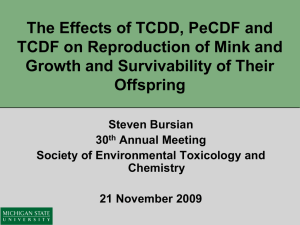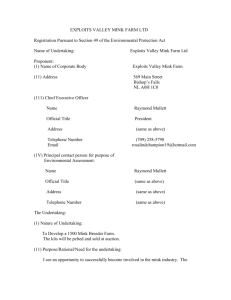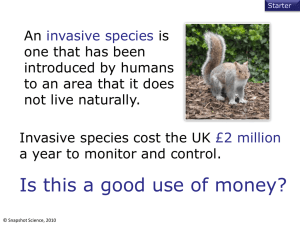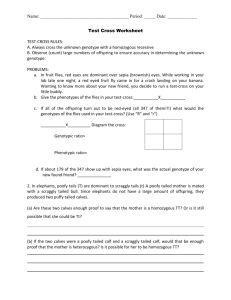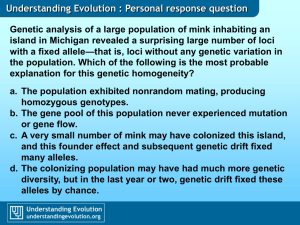EFFECTS OF DIETARY EXPOSURE OF MINK (MUSTELA VISON) TO 2,3,7,8-TETRACHLORODIBENZO-p-DIOXIN, 2,3,4,7,8-PENTACHLORODIBENZOFURAN,
advertisement
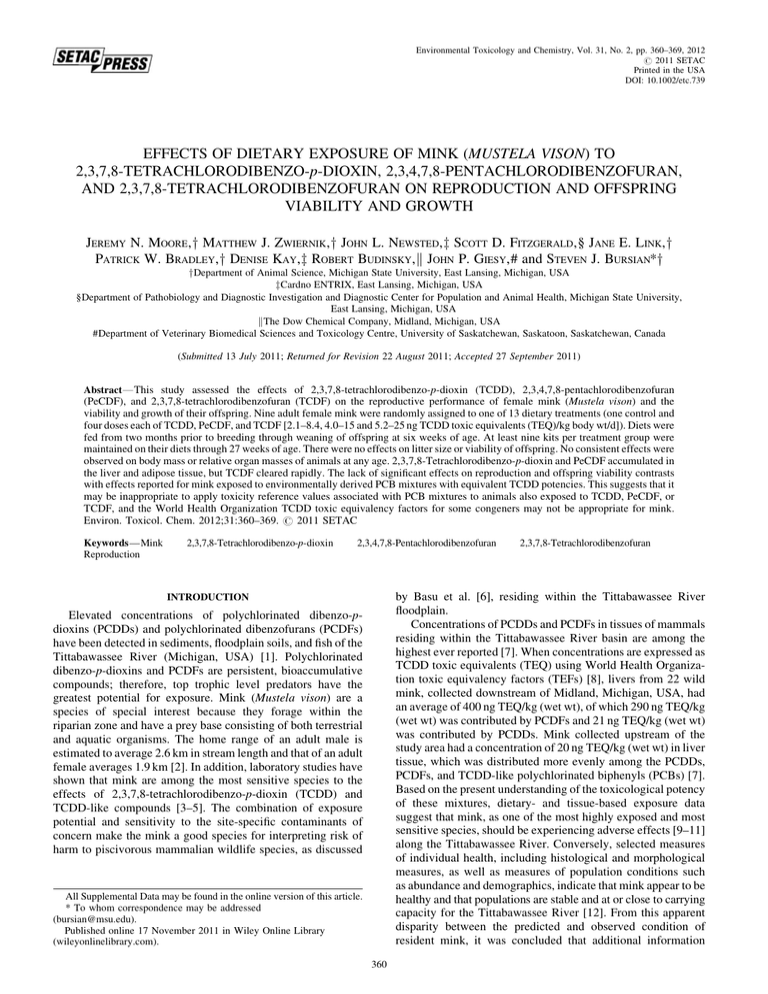
Environmental Toxicology and Chemistry, Vol. 31, No. 2, pp. 360–369, 2012 # 2011 SETAC Printed in the USA DOI: 10.1002/etc.739 EFFECTS OF DIETARY EXPOSURE OF MINK (MUSTELA VISON) TO 2,3,7,8-TETRACHLORODIBENZO-p-DIOXIN, 2,3,4,7,8-PENTACHLORODIBENZOFURAN, AND 2,3,7,8-TETRACHLORODIBENZOFURAN ON REPRODUCTION AND OFFSPRING VIABILITY AND GROWTH JEREMY N. MOORE,y MATTHEW J. ZWIERNIK,y JOHN L. NEWSTED,z SCOTT D. FITZGERALD,§ JANE E. LINK,y PATRICK W. BRADLEY,y DENISE KAY,z ROBERT BUDINSKY,k JOHN P. GIESY,# and STEVEN J. BURSIAN*y yDepartment of Animal Science, Michigan State University, East Lansing, Michigan, USA zCardno ENTRIX, East Lansing, Michigan, USA §Department of Pathobiology and Diagnostic Investigation and Diagnostic Center for Population and Animal Health, Michigan State University, East Lansing, Michigan, USA kThe Dow Chemical Company, Midland, Michigan, USA #Department of Veterinary Biomedical Sciences and Toxicology Centre, University of Saskatchewan, Saskatoon, Saskatchewan, Canada (Submitted 13 July 2011; Returned for Revision 22 August 2011; Accepted 27 September 2011) Abstract— This study assessed the effects of 2,3,7,8-tetrachlorodibenzo-p-dioxin (TCDD), 2,3,4,7,8-pentachlorodibenzofuran (PeCDF), and 2,3,7,8-tetrachlorodibenzofuran (TCDF) on the reproductive performance of female mink (Mustela vison) and the viability and growth of their offspring. Nine adult female mink were randomly assigned to one of 13 dietary treatments (one control and four doses each of TCDD, PeCDF, and TCDF [2.1–8.4, 4.0–15 and 5.2–25 ng TCDD toxic equivalents (TEQ)/kg body wt/d]). Diets were fed from two months prior to breeding through weaning of offspring at six weeks of age. At least nine kits per treatment group were maintained on their diets through 27 weeks of age. There were no effects on litter size or viability of offspring. No consistent effects were observed on body mass or relative organ masses of animals at any age. 2,3,7,8-Tetrachlorodibenzo-p-dioxin and PeCDF accumulated in the liver and adipose tissue, but TCDF cleared rapidly. The lack of significant effects on reproduction and offspring viability contrasts with effects reported for mink exposed to environmentally derived PCB mixtures with equivalent TCDD potencies. This suggests that it may be inappropriate to apply toxicity reference values associated with PCB mixtures to animals also exposed to TCDD, PeCDF, or TCDF, and the World Health Organization TCDD toxic equivalency factors for some congeners may not be appropriate for mink. Environ. Toxicol. Chem. 2012;31:360–369. # 2011 SETAC Keywords—Mink Reproduction 2,3,7,8-Tetrachlorodibenzo-p-dioxin 2,3,4,7,8-Pentachlorodibenzofuran 2,3,7,8-Tetrachlorodibenzofuran by Basu et al. [6], residing within the Tittabawassee River floodplain. Concentrations of PCDDs and PCDFs in tissues of mammals residing within the Tittabawassee River basin are among the highest ever reported [7]. When concentrations are expressed as TCDD toxic equivalents (TEQ) using World Health Organization toxic equivalency factors (TEFs) [8], livers from 22 wild mink, collected downstream of Midland, Michigan, USA, had an average of 400 ng TEQ/kg (wet wt), of which 290 ng TEQ/kg (wet wt) was contributed by PCDFs and 21 ng TEQ/kg (wet wt) was contributed by PCDDs. Mink collected upstream of the study area had a concentration of 20 ng TEQ/kg (wet wt) in liver tissue, which was distributed more evenly among the PCDDs, PCDFs, and TCDD-like polychlorinated biphenyls (PCBs) [7]. Based on the present understanding of the toxicological potency of these mixtures, dietary- and tissue-based exposure data suggest that mink, as one of the most highly exposed and most sensitive species, should be experiencing adverse effects [9–11] along the Tittabawassee River. Conversely, selected measures of individual health, including histological and morphological measures, as well as measures of population conditions such as abundance and demographics, indicate that mink appear to be healthy and that populations are stable and at or close to carrying capacity for the Tittabawassee River [12]. From this apparent disparity between the predicted and observed condition of resident mink, it was concluded that additional information INTRODUCTION Elevated concentrations of polychlorinated dibenzo-pdioxins (PCDDs) and polychlorinated dibenzofurans (PCDFs) have been detected in sediments, floodplain soils, and fish of the Tittabawassee River (Michigan, USA) [1]. Polychlorinated dibenzo-p-dioxins and PCDFs are persistent, bioaccumulative compounds; therefore, top trophic level predators have the greatest potential for exposure. Mink (Mustela vison) are a species of special interest because they forage within the riparian zone and have a prey base consisting of both terrestrial and aquatic organisms. The home range of an adult male is estimated to average 2.6 km in stream length and that of an adult female averages 1.9 km [2]. In addition, laboratory studies have shown that mink are among the most sensitive species to the effects of 2,3,7,8-tetrachlorodibenzo-p-dioxin (TCDD) and TCDD-like compounds [3–5]. The combination of exposure potential and sensitivity to the site-specific contaminants of concern make the mink a good species for interpreting risk of harm to piscivorous mammalian wildlife species, as discussed All Supplemental Data may be found in the online version of this article. * To whom correspondence may be addressed (bursian@msu.edu). Published online 17 November 2011 in Wiley Online Library (wileyonlinelibrary.com). 360 Reproductive effects of TCDD, PeCDF, and TCDF on mink on the potency of the toxic mixture of compounds found in the Tittabawassee River soils, sediments, and wildlife was needed. To provide risk managers with the best possible information pertaining to the potency of the site-specific contaminant mixture, a controlled feeding study was conducted in which ranch mink were exposed to relevant PCDD and PCDF congeners at concentrations bracketing those observed in the field. These included TCDD, 2,3,4,7,8-pentachlorodibenzofuran (PeCDF), and 2,3,7,8-tetrachlorodibenzofuran (TCDF), which were the three compounds that made up the majority of calculated toxic potency based on TEQ using current World Health Organization TEFs [8]. Because the present study design included TCDD in a side-by-side comparison of toxicity to the two furans, the results also provide animal-based relative potency data that can be used by the World Health Organization for calculating the mammalian TEFs for PeCDF and TCDF. In addition to bracketing field exposures, the dosing regime was expanded to cover a range of concentrations including those expected to elicit effects previously reported for mink exposed to TCDD-like compounds. Lesser doses were set to mimic nominal environmentally relevant concentrations and were expected to result in no effects except for the most sensitive responses at the molecular level. In contrast, the highest dose for each congener expressed as TEQ using current World Health Organization TEFs [10] (TCDD ¼ 8.4 ng TEQTCDD/kg body wt/d, PeCDF ¼ 15 ng TEQPeCDF/kg body wt/d, and TCDF ¼ 25 ng TEQTCDF/kg body wt/d) exceeded the median predicted environmental exposures for the Tittabawassee River of 3.9 ng TEQ/kg body wt/d. This highest dose was expected to cause reproductive effects based on the results of laboratory studies in which mink fed TEQ-normalized concentrations of PCBs [5,9–11,13–15] at similar levels experienced decreased litter size and/or reduced offspring viability. The present report describes the effects of consumption of diets containing various concentrations of TCDD, PeCDF, or TCDF on adult female reproductive performance and offspring viability and growth through 27 weeks of age. MATERIALS AND METHODS Chemicals and reagents 2,3,7,8-tetrachlorodibenzo-p-dioxin, PeCDF, and TCDF were obtained from AccuStandard and dissolved in hexane (OmniSolv; EMD Chemicals) to produce a stock solution for each congener. Working solutions of TCDD, PeCDF, and TCDF were then prepared by serial dilution in hexane. One milliliter of each working solution was added to 100 ml corn oil for incorporation into the feed. Dietary treatments The treatment diets were based on the Michigan State University (MSU) Experimental Fur Farm ranch diet formulated to meet the nutritional requirements of mink (Table 1) [16]. The treatment diets were prepared by adding water to a 500-kg-capacity paddle mixer, followed by fishmeal, wheat middlings, and soybean oil. These ingredients were mixed thoroughly prior to adding the working solutions, which had been diluted 1:100 with corn oil. A solution of 1 ml hexane and 100 ml corn oil was added to the control feed. After an additional period of mixing to allow the hexane to evaporate, the remaining ingredients were added and mixed thoroughly. Three grab samples consisting of five subsamples per grab sample were collected for each diet for congener analysis (Vista Laboratories), as well as a sample for nutrient analysis Environ. Toxicol. Chem. 31, 2012 361 Table 1. Composition and nutrient analysis of basal experimental diets (as-fed basis) Ingredient Water Soybean oila Spray-dried poultry liverb Spray-dried eggsb Spray-dried blood cellsc Chickend Wheat middlingsa Fishmeala Vitamin premixe Mineral premixf Phosphoric acidg Larvacideh (ml/kg feed) d-Biotini (mg/kg feed) Nutrient analysis (%) Moisture Protein Fat Ash Crude fiber Total digestible nutrients Composition (%) 34.0 6.0 4.0 5.0 4.0 26.0 15.0 4.0 0.5 0.5 1.0 0.2 2.4 53.8 17.6 11.0 4.7 1.7 43.9 a North American Nutrition. VanElderen. c California Spray Dry. d Whole ground chicken. e Calcium, 13.40%; copper, 2,000 mg/kg; iodine, 30 mg/kg; iron, 2.0%; manganese, 2,000 mg/kg; selenium, 60 mg/kg; zinc, 2.0%; Akey. f Vitamin A, 916,652 IU/kg; vitamin D3, 91,674 IU/kg; vitamin E, 11,000 IU/kg; vitamin K activity, 2,200 mg/kg; menadione, 733 mg/kg; vitamin B12, 5.5 mg/kg; riboflavin, 733 mg/kg; d-pantothenic acid, 2,935 mg/kg; niacin, 4,400 mg/kg; thiamine, 183 mg/kg; pyridoxine, 33 mg/kg; Akey. g Astaris. h Active ingredient: cyromazine (N-cyclopropyl-1,3,5-triazine-2,4,6-triamine, 2%); Novartis Animal Health. i Biotin 100 (100 mg/lb); ADM. b (Litchfield Analytical Services). The treatment diets were packaged in labeled, one-gallon aluminum containers that were stored in a walk-in freezer (208C) at the MSU Experimental Fur Farm. Twenty-four hours prior to use, containers were transferred from the walk-in freezer to a walk-in cooler (48C) to allow the feed to thaw. One container was sufficient to feed a group of nine mink for approximately 3 d. Feed was mixed and sampled a second time halfway through the trial as described above. Targeted dietary concentrations were 21, 42, 73, and 104 ng TCDD/kg feed; 139, 243, 347, and 533 ng PeCDF/kg feed; and 728, 1,600, 2,560, and 3,120 ng TCDF/kg feed. Actual dietary concentrations reflecting both mixes, as determined by highresolution gas chromatography/high-resolution mass spectrometry, and daily doses of TCDD, PeCDF, and TCDF as well as the corresponding TEQ (based on TEFs reported by Van den Berg et al. [8]) are presented in Table 2. The TEQ concentration for each of the TCDD, PeCDF, and TCDF groups reflects the concentration provided by that congener only because the TEQ contributed by other congeners were less than 1% of the total. Dose calculations were based on the average estimated feed consumption and body mass of adult females in each treatment group through the first 15 weeks of the trial. Feed consumption was estimated by providing each animal with a daily allotment of 125 g feed, which was slightly greater than the consumption of 115 g/d previously reported for adult female ranch mink [17], and determining the amount feed remaining at the time of next feeding. 362 Environ. Toxicol. Chem. 31, 2012 J.N. Moore et al. Table 2. Dietary concentrations and corresponding doses of 2,3,7,8-tetrachlorodibenzo-p-dioxin (TCDD), 2,3,4,7,8-pentachlorodibenzofuran (PeCDF), and 2,3,7,8-tetrachlorodibenzofuran (TCDF) Estimated dosea Dietary concentration Treatment TCDD PeCDF TCDF ng/kg feed SEb ng TEQc/kg feed Mean estimated daily feed intake week 1–15 (g) 23 53 77 101 166 288 363 619 679 1,464 2,402 2,866 0.6 1.6 2.6 3.9 3.1 4.7 23.2 12.2 21.3 35.3 150.5 163.6 23 53 77 101 50 86 109 186 68 146 240 287 99.5 103.2 100.3 102.3 99.1 102.8 99.3 96.8 100.0 99.3 99.1 93.5 SE Mean body weight week 1–15 (g) SE ng/kg body wt/d ng TEQ/kg body wt/d 1.1 0.5 0.9 0.8 0.9 0.6 0.9 0.9 1.0 1.0 1.0 1.2 1,088 1,187 1,286 1,226 1,241 1,172 1,207 1,215 1,318 1,254 1,110 1,091 27 31 21 23 14 23 29 20 26 26 19 30 2.1 4.6 6.0 8.4 13 25 30 49 52 116 214 246 2.1 4.6 6.0 8.4 4.0 7.6 9.0 15 5.2 12 21 25 a Dose based on estimated feed consumed from a daily allotment of 125 g feed and mean body weights (body wt) of adult female mink through week 15 of the study. b SE ¼ Standard error. c TEQ refers to toxic equivalents that are based on toxic equivalency factors of 1.0, 0.3, and 0.1 for TCDD, PeCDF, and TCDF [8]. Animals One hundred seventeen first-year (virgin) and second-year (proved breeder), natural dark, female mink from the MSU Experimental Fur Farm herd were assigned randomly on November 20, 2006 to 13 dietary treatment groups (nine mink per group) with the exception that littermates were not placed in the same treatment group to minimize genetic predisposition to compound toxicity. Untreated, natural dark, male mink were used for breeding purposes only. The MSU Institutional Animal Care and Use Committee approved the use of animals for this trial. Housing Female mink were housed individually in wire breeder cages (76 cm L 46 cm W 38 cm H) suspended above the ground in an open-sided mink shed. Nine animals per treatment group were assigned randomly to a bank of nine cages separated from the next bank of nine cages by an empty cage. Assignment of treatments to banks of cages was done to minimize the potential for cross-contamination between groups. A wooden nest box (38 cm L 25 cm W 29 cm H) bedded with excelsior (wood wool) prebreeding or aspen shavings postbreeding was attached to the outside of each cage. The standard guidelines for operating mink farms in the United States [18] were followed to house and maintain the animals. Exposure period Mink were started on their treatment diets on December 30, 2006, after a one-week acclimation period. The daily allotment of feed (125 g) was placed on a cleaned grid on the top of the cage. Water was available ad libitum. Animals were weighed every four weeks until the initiation of breeding (March 1, 2007). Adult females were mated to untreated males between March 1 and March 26, 2007. Each female was given an opportunity to mate every fourth day until a successful mating was obtained. Females were assumed to have bred successfully if evidence of vulvar swelling appeared following a copulation period of at least 10 min. Mated females were given an opportunity to breed with a different male the day following a successful mating and on the eighth and ninth days after the first successful mating (a common commercial mink breeding practice). Whelping began on April 15, 2007 and ended on May 15, 2007. Nest boxes were checked on a daily basis for the presence of mink kits. Live kits were enumerated, and body masses were recorded at birth and at three and six weeks of age. Body masses of adult females were recorded at the time their litters were weighed. All surviving adults and a representative number of kits from each treatment group were euthanized (CO2) when kits were six weeks old (May 22 to June 25, 2007). These individuals were necropsied, and samples of selected tissues were taken for analytical and histological assessment. At least nine kits per treatment were maintained on their diets until they were 27 weeks old (October 22 to November 2, 2007), at which time they were euthanized and processed as described above. At least four males and four females, but no more than nine mink, were selected randomly from each treatment for the final necropsy and tissue analysis. The thyroid gland, thymus, heart, adrenal glands, kidneys, spleen, reproductive organs (uterus with ovaries/testes), liver, and brain were removed, weighed, and placed in 10% neutral buffered formalin for subsequent histological assessment. Chemical analysis To ensure that cocontaminants were not a factor in the present study, concentrations of 17 2,3,7,8-substituted PCDF and PCDD congeners and 12 TCDD-like PCB congeners were measured in the dietary items, feed samples, and liver tissue as described by Zwiernik et al. [19]. Cocontainments accounted for less than 1% of the TEQ contributed by TCDD, PeCDF, or TCDF. Thus, concentrations of dietary and hepatic TEQ for each of the TCDD, PeCDF, and TCDF treatment groups were calculated as the product of the concentration of that congener only multiplied by its respective TEF [8]. A surrogate value of one-half the method detection limit (MDL) was used for concentrations less than the MDL. Liver tissues were extracted following a modification of U.S. Environmental Protection Agency (U.S. EPA) method 1613B [20]. Liver tissue extracts were shipped on dry ice to Vista Laboratories for congener Reproductive effects of TCDD, PeCDF, and TCDF on mink Environ. Toxicol. Chem. 31, 2012 analysis by high-resolution gas chromatography/high-resolution mass spectrometry according to U.S. EPA method 1613B [20]. 363 treatment groups compared with controls through six weeks of age (Table 3). Although differences in kit viability among dose groups were not statistically significant because of sample size and variability, the percentages of viable kits in the control and low-dose PeCDF groups were numerically greater compared with the other groups. Histological analysis Histological examination of tissues was performed at MSU’s Diagnostic Center for Population and Animal Health. Tissues were embedded in paraffin, sectioned at 5 mm, and stained with hematoxylin and eosin. A board-certified veterinary pathologist examined slides of the thyroid gland, thymus, heart, adrenal glands, kidneys, spleen, reproductive organs (uterus with ovaries/testes), liver, brain, and maxilla and mandible of each mink sampled at necropsy. Body mass Mean body masses of adult females prior to the whelping period were not significantly different compared with controls (Table 4). Similarly, no significant differences were noted in mean body masses of kits at birth and six weeks of age compared with controls (Table 3). Conversely, some significant treatment-related differences were observed in juvenile male mean body masses compared with controls at weeks 14 and 27. Treatment differences were generally not consistent in terms of age and/or dose (Table 4). The mean body mass of male juveniles exposed to the highest dose of TCDD (8.4 ng/kg body wt/d; 8.4 ng TEQTCDD/kg body wt/d) was significantly less than the mean body mass of the control group counterparts at week 14 of the trial; however, by week 27, masses were no longer different. For the next-lesser-dose TCDD group (6.0 ng TCDD/kg body wt/d; 6.0 ng TEQTCDD/kg body wt/d), male mean body mass did not differ from the control group counterparts at week 14 but did differ at week 27. In males exposed to PeCDF, mean body masses were significantly less compared with controls at weeks 14 and 27 in the 25 and 49 ng PeCDF/kg body wt/d (7.6 and 15 ng TEQPeCDF/kg body wt/d) treatment groups but not in the 30 ng PeCDF/kg body wt/d (9.0 ng TEQTCDD/kg body wt/d) group. Only at the highest dose of TCDF (246 ng TCDF/kg body wt/d; 25 ng TEQTCDF/kg body wt/d) was mean body mass of juvenile males significantly different compared with controls at 14 weeks of age but not at 27 weeks of age. Regardless of congener or dose, mean body mass in juvenile females did not differ significantly from controls (Table 4). Statistical analysis All statistical analyses were performed with SAS Version 9.1. Because of the nature of the parameters, several statistical models were used for data analyses. The present study was designed for the application of fixed effects models to test for differences among exposure groups. Prior to conducting statistical comparisons, data were tested for normality using the Shapiro–Wilkes test and probability plots. If necessary, values were log transformed to approximate normality. Differences among treatment groups were evaluated by analysis of variance using SAS PROC Mixed. Because of the unbalanced experimental design (unequal sample sizes), least square means were used in the analyses. When group effects were statistically significant, differences among treatment groups were tested with Tukey–Kramer test to account for differences in sample size among the groups. Differences among groups were considered significant at p < 0.05. RESULTS Reproductive performance and offspring viability All females bred at least once. The percentage of bred females whelping ranged from 78 to 100% with the exception of the highest PeCDF treatment group (49 ng PeCDF/kg body wt/d or 15 ng TEQPeCDF/kg body wt/d), which had a 56% whelping rate. Mean litter sizes at birth for females that whelped were not significantly different from those of the control group irrespective of the treatment compound or dose. Similarly, no significant differences were observed in kit viability among Organ mass Relative masses (percentage of body mass) of the spleen and liver were greater compared with controls at the highest doses of the three congeners, depending on age, whereas changes in relative masses of other organs were inconsistent across doses (Table 5). Mean relative spleen mass in the adult females Table 3. Effects of 2,3,7,8-tetrachlorodibenzo-p-dioxin (TCDD), 2,3,4,7,8-pentachlorodibenzofuran (PeCDF), and 2,3,7,8-tetrachlorodibenzofuran (TCDF) on reproduction, kit growth, and viability through six weeks of agea Treatment Control TCDD PeCDF TCDF a Dose (ng/kg body wt/d) 0 2.1 4.6 6.0 8.4 13 25 30 49 52 116 214 246 No. of females whelping/total no. of females 9 7 7 8 8 8 8 8 5 9 9 8 7 of of of of of of of of of of of of of 9 9b 9 9c 9 9 9 9 9d 9 9 9 9 Litter size (live kits) 6.1 5.6 4.9 5.7 4.6 5.4 4.8 5.4 4.4 4.4 5.9 4.6 5.1 (0.70) (0.80) (0.80) (0.70) (0.70) (0.80) (0.80) (0.80) (1.00) (0.70) (0.70) (0.80) (0.80) Mean body mass (g) at birth 9.91 7.57 8.39 9.3 9.95 8.65 9.53 9.9 9.68 10.19 9.22 9.04 7.7 (0.60) (0.70) (0.70) (0.60) (0.60) (0.60) (0.60) (0.70) (0.80) (0.60) (0.60) (0.70) (0.70) Data are presented as means with standard error or 95% confidence interval in parentheses. One female died due to renal failure caused by bacterial pyelonephritits. Uterus contained six fetuses. c One female died due to bacterial pneumonia. Uterus did not contain fetuses. d One female died due to ruptured uterus. Uterus contained five fetuses. b Mean body mass (g) at six weeks 250.13 215.6 182.06 255.27 181.12 275.39 184.04 172.78 180.5 228.73 238.13 228.08 181.75 (23.50) (33.30) (33.30) (27.27) (27.20) (23.50) (29.80) (27.20) (33.30) (25.10) (22.20) (29.80) (27.20) Viability through six weeks of age (%) 80.3 46.3 53.1 51.6 67.7 81.3 36.3 51.5 65.0 51.8 61.1 57.1 66.7 (0.5–1.1) (0.0–0.9) (0.1–1.0) (0.2–0.8) (0.3–1.0) (0.6–1.0) (0.0–0.7) (0.2–0.9) (0.1–1.2) (0.2–0.9) (0.4–0.9) (0.2–1.0) (0.3–1.0) 364 Environ. Toxicol. Chem. 31, 2012 J.N. Moore et al. Table 4. Effects of 2,3,7,8-tetrachlorodibenzo-p-dioxin (TCDD), 2,3,4,7,8-pentachlorodibenzofuran (PeCDF), and 2,3,7,8-tetrachlorodibenzofuran (TCDF) on adult female prewhelping mass (g) and juvenile male and female mass (g) from 14 to 27 weeks of agea Adult females Treatment Control TCDD PeCDF TCDF a Dose (ng/kg body wt/d) n 0 2.1 4.6 6.0 8.4 13 25 30 49 52 116 214 246 9 8 9 8 9 9 9 9 8 9 9 9 9 Week 0 prewhelping 1,275 1,274 1,311 1,326 1,264 1,250 1,303 1,244 1,272 1,387 1,350 1,256 1,248 (62) (62) (62) (62) (62) (62) (62) (62) (62) (62) (62) (62) (62) Juvenile males Week 15 prewhelping 1,290 1,018 1,225 1,362 1,285 1,284 1,254 1,270 1,215 1,373 1,249 1,096 1,095 (49) (49) (49) (49) (49) (49) (49) (49) (49) (49) (49) (49) (49) n 12 7 7 6 9 10 3 7 7 9 12 9 9 Week 14 1,164 972 1,066 950 841 A 1,037 866 A 1,066 805 A 1,102 1,055 926 911 A (58) (72) (72) (75) (58) (51) (75) (56) (70) (58) (52) (61) (56) Juvenile females Week 27 n Week 14 1,537 (79) 1,355 (96) 1,285 (96) 1,073 A (102) 1,226 (81) 1,307 (70) 1,093 A (123) 1,494 (83) 1,119 A (88) 1,354 (89) 1,572 (79) 1,357 (92) 1,304 (86) 17 7 7 16 7 13 7 8 2 4 12 9 9 802 836 765 815 689 795 733 762 651 869 816 712 737 (41) (66) (60) (76) (60) (44) (63) (55) (109) (61) (45) (46) (49) Week 27 1,164 999 983 1,013 952 1,123 938 1,043 821 1,026 1,144 1,008 1,035 (53) (86) (78) (60) (78) (63) (90) (79) (155) (79) (57) (59) (63) Data are presented as means with standard error in parentheses. Means that are significantly different from the control mean at p < 0.05 are designated with an uppercase letter A. receiving the highest dose of TCDD (8.4 ng TCDD/kg body wt/d; 8.4 ng TEQ/kg body wt/d) was significantly greater compared with controls (mean [95% confidence interval]; 0.34 [0.30–0.42] vs 0.25 [0.22–0.28]) as was mean relative spleen mass in the juvenile males dosed with 8.4 ng TCDD/kg body wt/d (8.4 ng TEQTCDD/kg body wt/d). Mean relative liver masses of juvenile males at the highest PeCDF (49 ng PeCDF/kg body wt/d; 15 ng TEQPeCDF/kg body wt/d) and TCDF (246 ng TCDF/kg body wt/d; 25 ng TEQTCDF/kg body wt/d) doses were significantly greater compared with controls. There appeared to be a dose-related trend of increasing relative liver masses in the TCDD and PeCDF groups. Other significant changes in relative organ masses included increased mean relative kidney masses at 4.6 ng TCDD/kg body wt/d (4.6 ng TEQTCDD/kg body wt/d) and 25 and 49 ng PeCDF/kg body wt/d (7.6 and 15 ng TEQPeCDF/kg body wt/d) in juvenile males. In juvenile females, mean relative thymus masses were significantly decreased at 6.0 ng TCDD/kg body wt/d (6.0 ng TEQTCDD/kg body wt/d) and 52 ng TCDF/kg body wt/d (5.2 ng TEQTCDF/kg body wt/d); mean relative heart masses were significantly increased at 6.0 ng TCDD/kg body wt/d (6.0 ng TEQTCDD/kg body wt/d) and 25 ng PeCDF/kg body wt/d (7.6 ng TEQPeCDF/kg body wt/d); and mean relative adrenal gland mass was significantly increased at 8.4 ng TCDD/kg body wt/d (8.4 ng TEQTCDD/kg body wt/d) compared with controls. Absolute and relative masses for all adult female, kit, and juvenile organs are presented in Supplemental Data, Tables S1 to S10. Pathology Exposure to TCDD, PeCDF, and TCDF did not induce any consistent treatment-related histological changes in the tissues examined, with the exception of mandibular and maxillary squamous epithelial proliferation in six-week-old kits and 27-week-old juveniles (S. Bursian et al., unpublished results) and significant mineralization of the liver, heart, and thyroid gland in juveniles exposed to the highest dose of TCDF (246 ng TCDF/kg body wt/d; 25 ng TEQTCDF/kg body wt/d; Table 6). Additionally, in both six-week-old kits (data not shown) and 27week-old juveniles, evidence of mild renal mineralization and hepatic vacuolation was observed in all dose groups, including the controls. Hepatic and adipose TCDD/PeCDF/TCDF concentrations Concentrations of TCDD, PeCDF, and TCDF in liver and adipose tissue of adult females and 27-week-old juveniles generally increased with dose (Table 7). Concentrations of the three congeners in livers of adults were significantly different from those in livers of controls at the three highest doses of TCDD, all doses of PeCDF, and the two highest doses of TCDF. In adult female adipose tissue, concentrations of TCDD, PeCDF, and TCDF were significantly greater than control concentrations at all doses. Congener concentrations in livers of juvenile mink fed TCDD, PeCDF, and TCDF were significantly greater than those in livers of controls at all doses except the lowest doses of TCDD and TCDF. Concentrations of TCDD, PeCDF, and TCDF in adipose tissue of juveniles were significantly greater at all doses than those in adipose tissue of unexposed juvenile mink. Concentrations were generally similar between adults and juveniles. Bioaccumulation factors were generally consistent across treatment groups for each congener (Table 7). Bioaccumulation factors were greater than one for TCDD and PeCDF in both liver and adipose tissue of adults and juveniles but less than one for TCDF in all treatment groups. The bioaccumulation factors indicated that TCDD bioaccumulated to a greater extent in adipose tissue than in the liver, whereas PeCDF bioaccumluated to a greater extent in liver than in adipose tissue. 2,3,7,8Tetrachlorodibenzofuran did not bioaccumulate in either tissue relative to the diet being fed. DISCUSSION Reproductive performance and offspring viability The reproductive performance of the control mink and viability of their offspring in the present study were comparable to those of control mink in two other reproduction trials [9,10] conducted at the MSU Experimental Farm using similar methodology. Average litter size at birth in the present study was 6.1 kits per litter compared with 5.7 [9] and 4.6 [10] kits per litter. Kit survivability through six weeks of age was 80.3% in the present study compared with 88.9 [9] and 85.0% [10]. Toxic equivalent doses of TCDD, PeCDF, and TCDF as high as 8.4 ng TEQTCDD/kg body wt/d, 15 ng TEQPeCDF/kg body Body mass data are presented as the least squares mean with standard error in parentheses. Relative organ mass data are presented as the mean with the 95% confidence interval in parentheses. Means that are significantly different from the control mean at p < 0.05 are designated with a letter A. (0.63–1.15) (0.62–0.78) (0.72–0.96) (0.70–0.89) A (0.01–0.11) (0.06–0.09) (0.06–0.09) (0.06–0.09) (80) (58) (61) (64) TCDF PeCDF Environ. Toxicol. Chem. 31, 2012 a (0.018–0.037) (0.026–0.037) (0.021–0.039) (0.021–0.032) (0.021–0.030) (0.024–0.047) (0.020–0.036) (0.025–0.032) A (0.033–0.043) (0.020–0.034) (0.025–0.053) (0.022–0.042) 0.026 0.035 0.028 0.029 0.038 0.027 0.039 0.032 0.028 0.027 0.031 0.030 0.027 (54) (87) (78) (60) (79) (63) (90) (79) 1,164 999 990 1,013 952 1,123 938 1,043 967 1,025 1, 144 1, 019 1, 035 17 7 8 16 7 13 7 8 1 4 12 8 9 (0.60–0.72) (0.07–0.84) (0.70–0.95) (0.74–0.92) (0.70–0.82) (0.65–0.80) (0.56–1.17) (0.62–0.74) (0.82–0.10) (0.65–0.80) (0.65–0.70) (0.67–0.82) (0.67–1.80) 0.66 0.75 0.83 A 0.83 0.76 0.72 0.86 A 0.68 0.91 A 0.73 0.68 0.75 0.74 (0.16–0.21) (0.16–0.20) (0.20–0.25) (0.16–0.20) (0.21–0.31) (0.17–0.22) (0.00–3.25) (0.23–0.32) (0.25–0.38) (0.14–0.28) (0.17–0.24) (0.19–0.28) (0.24–0.29) 0.19 0.18 0.22 0.18 0.26 A 0.19 0.78 0.27 0.31 0.21 0.20 0.24 0.27 (79) (96) (103) (103) (81) (71) (128) (85) (82) (90) (79) (90) (87) 1,536 1,355 1,295 1,072 A 1,225 1,307 1,093 A 1,497 1,057 A 1357 1,574 1,323 1,302 12 7 6 6 9 10 3 7 8 9 12 10 9 0 2.1 4.6 6.0 8.4 13 25 30 49 52 116 214 246 Control TCDD Treatment Dose (ng/kg body wt/d) n Body mass at necropsy (g) 5.1 5.19 5.54 5.99 5.97 5.38 6.67 5.70 6.83 A 4.99 4.98 5.31 5.85 A Liver (4.79–5.42) (4.28–6.11) (4.73–6.36) (5.23–6.75) (5.50–6.45) (4.62–6.15) (1.78–11.56) (5.35–6.06) (6.01–7.64) (4.50–5.48) (1.77–5.19) (4.87–5.75) (5.48–6.22) Spleen Kidneys n Body mass at necropsy (g) 0.11 0.08 0.09 0.07 0.08 0.09 0.07 0.07 0.06 0.06 0.08 0.07 0.07 (0.09–0.12) (0.06–0.11) (0.06–0.11) A (0.06–0.08) (0.06–0.10) (0.08–0.11) (0.04–0.09) (0.05–0.09) 0.71 0.83 0.85 0.92 0.86 0.78 0.96 0.76 0.76 0.89 0.70 0.84 0.80 (0.65–0.77) (0.70–0.97) (0.77–0.93) A (0.87–0.96) (0.72–0.99) (0.72–0.84) A (0.74–1.18) (0.68–0.84) Adrenal glands Heart Thymus Females Males Table 5. Effects of 2,3,7,8-tetrachlorodibenzo-p-dioxin (TCDD), 2,3,4,7,8-pentachlorodibenzofuran (PeCDF), and 2,3,7,8-tetrachlorodibenzofuran (TCDF) on juvenile male and female relative organ mass (% of body mass) at 27 weeks of agea Reproductive effects of TCDD, PeCDF, and TCDF on mink 365 wt/d, and 25 ng TEQTCDF/kg body wt/d had no significant effect on reproductive performance of mink or viability of their offspring. These doses corresponded to maternal hepatic TEQ concentrations of 364, 2,163, and 13 ng/kg (wet wt). However, only 56% of the bred females in the highest PeCDF dose group whelped compared with 100% in the control group. It is possible that the dose of 15 ng TEQPeCDF/kg body wt/d affected the whelping rate, although one of the four females not whelping died of a ruptured uterus that contained five fetuses, which was not considered treatment related. The females that did whelp had a mean litter size that did not differ from the mean litter size of control females. In a mink feeding study using 3,30 ,4,40 5-pentachlorobiphenyl (PCB 126), females fed diets containing 240 ng TEQPCB 126/kg feed (30 ng TEQPCB 126/kg body wt/d) and higher experienced complete reproductive failure, whereas animals fed a diet containing 24 ng TEQPCB 126/kg feed (3.0 ng TEQPCB 126/kg body wt/d) were not affected [5]. The general lack of an effect on reproductive performance and offspring viability was unexpected in that reproductive impairment and reduced offspring viability have been associated with similar or lesser TEQ doses in other mink feeding studies using a similar exposure scenario [5,10–13,15,21]. From studies using single congeners, Hochstein et al. [4] reported a 125-d LC50 value for TCDD in mink of 47 ng TEQTCDD/kg body wt/d, which is less than twice the highest TEQ dose provided by TCDF. Hochstein et al. [21] also attempted a mink reproduction study utilizing TCDD at estimated daily doses of 2.0, 6.6, 22.5, and 175 ng TEQTCDD/kg body wt/d (16, 53, 180, and 1,400 ng TEQTCDD/kg feed). An effect on reproduction could not be clearly determined because of subnormal reproductive performance of the control group, which was attributed to the fact that the trial was conducted indoors. The highest dose resulted in 17% adult mortality and a 26% decrease in body mass. Significant dose-dependent decreases were noted in kit birth mass and survival from birth to three weeks of age in the groups that had reproduced (animals in the 16 ng TEQTCDD/kg feed [2.0 ng TEQTCDD/kg body wt/d] did not reproduce). Zwiernik et al. [12] reported that dietary concentrations of 240 and 2,400 ng TCDF/kg feed (26 and 240 ng TEQTCDF/kg feed or estimated doses of 3.3 and 30 ng TEQTCDF/kg body wt/d) did not affect reproduction and kit viability, but body masses of offspring through 36 weeks of age were decreased compared with controls at various time points. Several mink feeding studies have been conducted using contaminated fish collected from specific bodies of water. In one such study, mink were fed diets containing fish collected from Saginaw Bay (MI, USA) that were contaminated with a mixture of PCB, PCDF, and PCDD congeners [13,15]. Mated females exposed to a dose of 8.3 ng TEQPCBs/PCDDs/PCDFs/kg body wt/d (based on a dietary concentration of 66 ng TEQPCBs/PCDDs/PCDFs/kg feed with TEQ recalculated using TEFs presented by Van den Berg et al. [8]) produced fewer live kits compared with controls, whereas a dose of 2.1 ng TEQPCBs/PCDDs/PCDFs/kg body wt/d (dietary concentration of 17 ng TEQPCBs/PCDDs/PCDFs/kg feed) significantly reduced kit viability through six weeks of age compared with controls. In another study of similar design, PCB/PCDF/PCDD-contaminated fish collected from the Housatonic River (MA, USA) resulting in a dose of 6.4 ng TEQPCBs/PCDDs/PCDFs/kg body weight/d (dietary concentration of 51 ng TEQPCBs/PCDDs/PCDFs/kg feed; TEQ recalculated using TEFs presented by Van den Berg et al. [8]) also had reduced kit viability at six weeks of age [10]. The corresponding maternal hepatic concentrations were 226 ng TEQPCBs/PCDDs/PCDFs/kg and 189 ng TEQPCBs/PCDDs/PCDFs/kg 366 Environ. Toxicol. Chem. 31, 2012 J.N. Moore et al. Table 6. Effects of dietary 2,3,7,8-tetrachlorodibenzo-p-dioxin (TCDD), 2,3,4,7,8-pentachlorodibenzofuran (PeCDF), and 2,3,7,8-tetrachlorodibenzofuran (TCDF) on organ histology of juvenile mink Treatment Control TCDD PeCDF TCDF Dose (ng/kg body wt/d) n Kidney mineralizationa Hepatic vacuolationb Hepatic mineralizationa,c Cardiac mineralizationa,c Thyroid mineralizationa,c 2.1 4.6 6.0 8.4 13 25 30 49 52 116 214 246 14 9 9 9 9 10 7 9 9 9 10 9 10 1.07 1.11 1.00 1.11 1.11 1.00 1.00 1.00 1.00 1.00 0.91 1.00 1.00 1.86 1.89 1.75 1.67 2.00 1.70 2.00 1.89 1.89 2.00 1.89 2.00 2.00 0 0 0 0 0 0 0 0 0 0 0 0.11 0.60 A 0 0 0 0 0.11 0.10 0.14 0 0 0.22 0.20 0.56 0.90 A 0 0 0 0 0 0 0 0 0 0 0 0.11 0.60 A A value of 1 ¼ mild mineralization; 2 ¼ moderate mineralization. A value of 1 ¼ mild fatty vacuolation; 2 ¼ moderate fatty vacuolation. c Means that are significantly different from the control mean at p < 0.05 are designated with a letter A. a b for the Saginaw Bay [13,15] and Housatonic River [13] studies. In contrast to the Saginaw Bay [13,15] and Housatonic River [11] studies and similar to the results in the present study, mink fed diets containing fish collected from the Saginaw River (MI, USA) at dietary concentrations of 22, 36, and 57 ng TEQPCBs/PCDDs/PCDFs/kg feed (TEQ were recalculated using TEFs presented by Van den Berg et al. [8]), which correspond to estimated doses of 2.8, 4.5, and 7.1 ng TEQPCBs/PCDDs/PCDFs/kg body wt/d, experienced no effects on reproduction or kit viability. The doses of TEQ in the present study at which no effects on reproduction or survival were noted were up to fourfold greater than doses of TEQ in those fish feeding studies that reported such effects. This apparent difference in toxicity between studies could be a reflection of the source of TEQ. Environmentally derived mixtures contain quantifiable PCBs and other identified TCDDlike contaminants that contribute to the calculated sum TEQ value, whereas single-congener studies provide a single congener source and subsequent TEQ value. In the Saginaw Bay study [13,15], PCB 126 contributed 62 and 53%, TCDD contributed 11 and 8%, and PeCDF contributed 6 and 24% of the dietary and hepatic TEQ, respectively. In the Saginaw River study [9], PCB 126 contributed 33 and 34%, TCDD contributed 16 and 8%, and PeCDF contributed 17 and 44% of the dietary and hepatic TEQ, respectively. In the Housatonic River study [10,11], PCB 126 contributed 81 and 85%, TCDD contributed less than 1%, and PeCDF contributed 7 and 6% of the dietary and hepatic TEQ, respectively. In mink feeding studies using dietary TEQ provided exclusively by PCB 126 [5] or TCDF [11], PCB 126 caused complete reproductive failure at a concentration that was one order of magnitude less than the greatest concentration of TCDF that resulted in no reproductive effects. Thus, despite the fact that PCB 126 and TCDF have an identical TEF of 0.1, it is apparent that, when provided individually, PCB 126 is considerably more toxic to mink than TCDF. The same relationship could also be true for PCB 126 compared with TCDD and PeCDF, explaining reproductive effects at lesser doses of TEQ that are provided primarily by PCB 126, as in the Saginaw Bay [13,15] and Housatonic River [10] studies compared with the present study. Body mass Exposure of mink to TCDD, PeCDF, and TCDF did not have a significant effect on body masses of adult females or male and female kits through six weeks of age and juvenile females through 27 weeks of age and had an inconsistent effect on juvenile male body mass at dietary TEQ concentrations as great as 287 ng/kg feed and TEQ doses up to 25 ng/kg body wt/d. The results of other mink feeding studies have indicated variable effects of TCDD-like chemicals on body mass. Adult female mink fed diets containing fish collected from Saginaw Bay that provided TEQPCBs/PCDDs/PCDFs concentrations as little as 17 ng/kg feed (2.1 ng/kg body wt/d) produced kits of significantly lesser body mass at three and six weeks of age compared with control animals [13]. Similarly, feeding mink diets containing 51 ng TEQPCBs/PCDDs/PCDFs/kg feed (6.4 ng TEQPCBs/PCDDs/PCDFs/kg body wt/d) derived from fish collected from the Housatonic River resulted in a transient decrease in kit body masses at three weeks of age, but body masses of adult females and juveniles were not affected [10]. Body masses of adult female mink and their offspring that were fed diets containing fish collected from the Saginaw River that provided up to 57 ng TEQPCBs/PCDDs/PCDFs/kg feed (7.1 ng TEQPCBs/PCDDs/PCDFs/kg body wt/d) were not adversely affected [9]. Body masses of offspring of mink fed a diet containing 24 ng TEQPCB 126/kg feed (3.0 ng TEQPCB 126/kg body wt/d) were not significantly different compared with controls [5]. Body masses of male mink kits exposed to TCDF in utero and during lactation at dietary concentrations of 24 and 240 ng TEQ/g feed (3.0 and 30 ng TEQTCDF/kg body wt/d) were less than those of controls at three weeks of age, and body masses of female offspring were less compared with those of controls from six to 36 weeks of age [12]. Organ mass Mink exposed to TCDD, PeCDF, or TCDF had relative organ masses that were different compared with controls in some cases, and, although the differences were not strictly dose dependent, with the exception of what appeared to be a trend of increasing relative liver masses with dose in juvenile males exposed to TCDD and TCDF, the changes were comparable to those reported in other mink feeding studies involving TCDD-like chemicals. In the present study, mean relative liver, heart, spleen, kidney, and adrenal gland masses were greater compared with controls for various doses of the three chemicals in the three age groups, and mean relative thymus masses were reduced. Adult female mink fed diets containing fish collected from Saginaw Bay that provided Reproductive effects of TCDD, PeCDF, and TCDF on mink Environ. Toxicol. Chem. 31, 2012 367 Table 7. Hepatic and adipose concentrations of 2,3,7,8-tetrachlorodibenzo-p-dioxin (TCDD), 2,3,4,7,8-pentachlorodibenzofuran (PeCDF), and 2,3,7,8tetrachlorodibenzofuran (TCDF) and bioaccumulation factors in adult female mink and their juvenile offspring Liver Dietary treatment Adults Control TCDD Control PeCDF Control TCDF Juveniles Control TCDD Control PeCDF Control TCDF a b c Dose (ng/kg body wt/d) 2.1 4.6 6.0 8.4 13 25 30 49 52 116 214 246 2.1 4.6 6.0 8.4 13 25 30 49 52 116 214 246 n Concn. (ng/kg wet wt) SEa 9 9 7 7 7 9 9 7 8 7 9 3 5 4 5 0.14 56 157 Ac 250 A 364 A 0.53 1,851 A 3,066 A 4,078 A 7,209 A 0.66 46 58 109 A 125 A 23.6 23.6 26.7 26.7 26.7 336 336 381 356 381 13.2 22.9 17.7 19.8 17.7 13 11 9 9 9 13 9 11 9 10 13 9 11 9 10 0.18 59 165 A 289 A 338 A 0.94 1,662 A 3,161 A 5,261 A 8,167 A 0.17 39 125 A 207 A 207 A 21.9 32.1 25.8 22.4 23.9 341 364 431 381 457 18.0 21.6 19.6 21.6 20.5 Adipose Concn. p Value Bioaccumulation dose vs. control factorb n (ng/kg wet wt) 0.4660 0.0009 <0.0001 <0.0001 0.0036 <0.0001 <0.0001 <0.0001 0.4560 0.1080 0.0014 <0.0001 0.0788 <0.0001 <0.0001 <0.0001 0.0002 <0.0001 <0.0001 <0.0001 0.0824 <0.0001 <0.0001 <0.0001 SE 2.33 2.46 2.93 3.23 3.61 4.08 11.2 10.7 11.2 11.7 0.250 0.068 0.040 0.045 0.044 6 7 7 7 5 6 6 5 7 7 6 3 3 4 3 0.89 344 A 540 A 969 A 1418 A 3.7 1,314 A 1,704 A 2,396 A 3,008 A 0.44 289 A 318 A 568 A 791 A 51.9 48.0 48.0 48.0 56.8 190 190 208 176 176 44.1 62.4 62.4 54.0 62.4 3.00 2.60 3.08 3.74 3.34 7.28 10.0 11.0 14.5 13.2 0.064 0.057 0.085 0.086 0.072 7 3 4 3 3 7 6 5 3 3 7 3 3 3 3 0.09 371 A 825 A 1,105 A 1,560 A 0.75 966 A 1,536 A 1,918 A 2,903 A 0.53 323 A 544 A 633 A 756 A 86.5 113 112 113 113 141 152 166 214 214 23.2 29.9 29.9 29.9 29.9 p Value Bioaccumulation dose vs. control factorb <0.0001 <0.0001 <0.0001 <0.0001 <0.0001 <0.0001 <0.0001 <0.0001 0.0004 0.0002 <0.0001 <0.0001 0.0065 <0.0001 <0.0001 <0.0001 <0.0001 <0.0001 <0.0001 <0.0001 <0.0001 <0.0001 <0.0001 <0.0001 14.8 15.1 10.1 12.5 14.1 26.2 7.92 5.93 6.59 4.86 0.170 0.425 0.217 0.237 0.276 15.5 16.4 15.5 14.3 15.5 5.36 5.82 5.34 5.28 4.69 0.200 0.475 0.372 0.264 0.264 Standard error. Bioaccumulation factor ¼ (liver or adipose concentration/feed concentration). Means that are significantly different from the control mean at p < 0.05 are designated with a letter A. from 17 to 66 ng TEQPCBs/PCDDs/PCDFs/kg feed (2.1–8.3 ng TEQPCBs/PCDDs/PCDFs/kg body wt/d, respectively) exhibited greater mean relative spleen and liver masses at all doses, greater mean relative adrenal gland masses at 33 and 66 ng TEQPCBs/PCDDs/PCDFs/kg feed (4.1 and 8.3 ng TEQPCBs/PCDDs/PCTEQDFs/kg body wt/d), and greater mean relative kidney mass at 66 ng TEQPCBs/PCDDs/PCDFs/kg feed (8.3 ng TEQPCBs/PCDDs/PCDFs/kg body wt/d) compared with controls [13]. Conversely, six-week-old kits generally had reduced mean relative organ masses at 17 and 33 ng TEQPCBs/PCDDs/PCDFs/kg feed (2.1 and 4.1 ng TEQPCBs/PCDDs/PCDFs/kg body wt/d). No kits survived in the 66 ng TEQPCBs/PCDDs/PCDFs/kg feed (8.3 ng TEQPCBs/PCDDs/PCDFs/kg body wt/d) treatment group [13]. The mean relative liver mass in six-week-old kits whelped by dams exposed to 36 and 57 ng TEQPCBs/PCDDs/PCDFs/kg feed (4.5 and 7.1 ng TEQPCBs/PCDDs/PCDFs/kg body wt/d) provided by fish collected from the Saginaw River were greater than those of individuals fed a control diet [7]. No differences were observed in mean organ masses of adult female mink fed diets that provided up to 51 ng TEQPCBs/PCDDs/PCDFs/kg feed (6.4 ng TEQPCBs/PCDDs/PCDFs/kg body wt/d) derived from fish collected from the Housatonic River relative to those of controls, but sixweek-old female kits in the 51 ng TEQPCBs/PCDDs/PCDFs/kg feed (6.4 ng TEQPCBs/PCDDs/PCDFs/kg body wt/d) treatment group had greater mean relative brain, kidney, and liver masses, and 31-week-old male and female juveniles from the same treatment group had increased relative spleen masses compared with controls [11]. Zwiernik et al. [12] reported no effects on organ masses in mink that had been exposed from conception through 72 weeks of age to 24 or 240 ng TEQTCDF/kg feed (3.0 and 30 ng TEQTCDF/kg body wt/d) provided by TCDF. Pathology Other than mandibular and maxillary squamous epithelial proliferation (S. Bursian et al., unpublished results) hepatic vacuolation and mineralization of the kidney, liver, heart, and thyroid gland were the only pathological effects noted in the present study. Hepatic vacuolation and renal mineralization occurred in juveniles in all treatment groups, including the control group, and so were not considered treatment related. These results are similar to those reported by Bursian et al. [11]. In contrast, Heaton et al. [14] reported that adult female mink exposed to PCBs/PCDDs/PCDFs at dietary concentrations ranging from 17 to 66 ng TEQPCBs/PCDDs/PCDFs/kg feed (2.1– 8.3 ng TEQPCBs/PCDDs/PCDFs/kg body wt/d) through dietary inclusion of fish collected from Saginaw Bay for a time period equivalent to that in the present study had enlarged and diffusely yellow livers. Histologically, the livers had various degrees of congestion, hepatocellular fatty change, and scattered aggregates of lymphocytes. Mineralization of the liver, thyroid gland, 368 Environ. Toxicol. Chem. 31, 2012 and heart in animals exposed to TCDF in the present study appeared to be related to dose. There are no reports in the literature of soft tissue mineralization induced by TCDD-like chemicals. Hepatic and adipose TCDD/PeCDF/TCDF concentrations Concentrations of TCDD, PeCDF, and TCDF in liver and adipose increased with dose. Bioaccumulation factors suggested that TCDD and PeCDF bioaccumulated in both liver and adipose tissue, although to different degrees, and that TCDF was eliminated rapidly from the animal. Results from a toxicokinetic study of PeCDF and TCDF in mink [19,22] are similar to those reported here, in that PeCDF accumulated in the liver of the mink to a much greater extent than did TCDF. This suggested hepatic sequestration of PeCDF, perhaps by binding of the congener to hepatic CYP1A2 protein, which has been shown to occur in rodents [23–26]. The lesser concentrations of TCDF in livers of mink suggested an efficient elimination and/or metabolism of the congener. The half-life of PeCDF was estimated to be approximately 8 d, whereas the half-life of TCDF was less than 0.5 d in mink [18]. These values are less than those reported for rodents. The half-life of TCDF is approximately 2 d in mice [23], and the half-life of PeCDF in the rat is more than 60 d [23]. CONCLUSIONS Results of the present study indicate that TEQ concentrations provided by TCDD, PeCDF, or TCDF, which were expected to result in complete reproductive failure in mink based on studies using environmentally derived mixtures of TCDD-like chemicals with calculated sum of TEQ, had no significant effects on reproductive performance of adult female mink or growth and viability of their offspring through 27 weeks of age. Additionally, minimal and, in some cases, inconsistent effects were seen on more subtle individual health endpoints, including organ masses and morphology. Hepatic and adipose concentrations of the three congeners suggested that PeCDF is preferentially sequestered in the liver more than in adipose tissue relative to TCDD and that TCDF is eliminated rapidly from the animal. Although the results of the present study are insufficient to calculate the relative potency of PeCDF and TCDF to TCDD for reproductive endpoints, unpublished histological data as well as comparisons with parallel studies suggest that the current TEF values might not accurately predict the toxic potency of TCDD, PeCDF, and TCDF compared with PCB 126 or environmental contaminant mixtures composed largely of PCB 126. SUPPLEMENTAL DATA Tables S1–S10. (27–31 KB XLS). Acknowledgement—This research received financial support from an unrestricted grant from The Dow Chemical Company. REFERENCES 1. Hilscherova K, Kannan K, Nakata H, Yamashita N, Bradley P, McCabe JA, Taylor A, Giesy J. 2003. Polychlorinated dibenzo-p-dioxin and dibenzofuran concentration profiles in sediments and flood-plain soils of the Tittabawassee River, Michigan. Environ Sci Technol 37:468–474. 2. Linscombe G, Kinler R, Aulerich RJ. 1982. Mink (Mustela vison). In Chapman JA, Feldhamer GA, eds, Wild Mammals of North America. Biology, Management and Economics. Johns Hopkins University Press, Baltimore, MD, USA, pp 629–643. 3. Hochstein JR, Aulerich RJ, Bursian SJ. 1988. Acute toxicity of 2,3,7,8tetrachlorodibenzo-p-dioxin to mink. Arch Environ Contam Toxicol 17:33–37. J.N. Moore et al. 4. Hochstein JR, Bursian SJ, Aulerich RJ. 1998. Effects of dietary exposure to 2,3,7,8-tetrachlorodibenzo-p-dioxin in adult female mink (Mustela vison). Arch Environ Contam Toxicol 35:348–353. 5. Beckett KJ, Yamini B, Bursian SJ. 2008. The effects of 3,30 ,4,40 ,5pentachlorobiphenyl (PCB 126) on mink (Mustela vison) reproduction and kit survivability and growth. Arch Environ Contam Toxicol 54: 123–129. 6. Basu N, Scheuhammer, Bursian SJ, Elliot J, Rouvinen-Watt K, Chan HM. 2007. Mink as a sentinel species in environmental health. Environ Res 103:130–144. 7. Zwiernik MJ, Kay DP, Moore J, Beckett KJ, Khim JS, Newsted JL, Roark SA, Giesy JP. 2008. Exposure and effects assessment of resident mink (Mustela vison) exposed to polychlorinated dibenzofurans and other dioxin-like compounds in the Tittabawassee River basin, Midland, MI, USA. Environ Toxicol Chem 27:2076–2087. 8. Van den Berg M, Birnbaum LS, Denison M, De Vito M, Farland W, Feeley M, Fiedler H, Hakansson H, Hanberg A, Haws L, Rose M, Safe S, Schrenk D, Tohyama C, Tritscher A, Tuomisto J, Tysklind M, Walker N, Peterson RE. 2006. The 2005 World Health Organization reevaluation of human and mammalian toxic equivalency factors for dioxins and dioxin-like compounds. Toxicol Sci 93:223–241. 9. Bursian SJ, Beckett KJ, Yamini B, Martin PA, Kannan K, Shields KL, Mohr FC. 2006. Assessment of effects in mink caused by consumption of carp collected from the Saginaw River, Michigan, USA. Arch Environ Contam Toxicol 50:614–623. 10. Bursian SJ, Sharma C, Aulerich RJ, Yamini B, Mitchell RR, Orazio C, Moore D, Sivirski S, Tillitt DE. 2006. Dietary exposure of mink (Mustela vison) to fish from the Housatonic River, Berkshire County, Massachusetts, USA: Effects on reproduction and kit growth and survival. Environ Toxicol Chem 25:1533–1540. 11. Bursian SJ, Sharma C, Aulerich RJ, Yamini B, Mitchell RR, Beckett KJ, Orazio CE, Moore D, Svirsky S, Tillitt DE. 2006. Dietary exposure of mink (Mustela vison) to fish from the Housatonic River, Berkshire County, MA, USA: Effects on organ weights and histology and hepatic concentrations of polychlorinated biphenyls and 2,3,7,8-tetrachlorodibenzo-p-dioxin toxic equivalents. Environ Toxicol Chem 25:1541–1550. 12. Zwiernik MJ, Beckett KJ, Bursian SJ, Kay DP, Holem RR, Moore JN, Yamini B, Giesy JP. 2009. Chronic effects of polychlorinated dibenzofurans on mink in laboratory and field environments. Integr Environ Assess Manag 5:291–301. 13. Heaton SN, Bursian SJ, Giesy JP, Tillitt DE, Render JA, Jones PD, Verbrugge DA, Kubiak TJ, Aulerich RJ. 1995. Dietary exposure of mink to carp from Saginaw Bay, Michigan. 1. Effects on reproduction and survival, and the potential risks to wild mink populations. Arch Environ Contam Toxicol 28:334–343. 14. Heaton SN, Bursian SJ, Giesy JP, Tillitt DE, Render JA, Jones PD, Verbrugge DA, Kubiak TJ, Aulerich RJ. 1995. Dietary exposure of mink to carp from Saginaw Bay, Michigan. 2. Hematology and liver pathology. Arch Environ Contam Toxicol 29:411–417. 15. Tillitt DE, Gale RW, Meadows JC, Zajicak JL, Peterman PH, Heaton SN, Jones PD, Bursian SJ, Kubiak TJ, Giesy JP, Aulerich RJ. 1996. Dietary exposure of mink to carp from Saginaw Bay, Michigan. 3. Characterization of dietary exposure to planar halogenated hydrocarbons, dioxinequivalents and biomagnifications. Environ Sci Technol 30:283–291. 16. National Research Council. 1982. Nutrient Requirements of Mink and Foxes, Vol 7—Nutrient Requirements of Domestic Animals. National Academy of Sciences, Washington, DC. 17. Bleavins MR, Aulerich RJ. 1981. Feed consumption and food passage time in mink (Mustela vison) and European ferrets (Mustela putorius furo). Lab Anim Sci 3:268–269. 18. Fur Commission U.S.A. 2003. Standard Guidelines for the Operation of Mink Farms in the United States. Coronado, CA, USA. 19. Zwiernik MJ, Bursian S, Aylward LL, Kay DP, Moore J, Rowlands C, Woodburn K, Shotwell M, Khim JS, Giesy JP, Budinsky RA. 2008. Toxicokinetics of 2,3,7,8-TCDF and 2,3,4,7,8-PeCDF in mink (Mustela vison) at ecologically relevant exposures. Toxicol Sci 105:33–43. 20. Telliard WA. 1994. Tetra- through octa-chlorinated dioxins and furans by isotope dilution HRGC/HRMS. Method 1613. U.S. Environmental Protection Agency, Washington, DC. 21. Hochstein JR, Render JA, Bursian SJ, Aulerich RJ. 2001. Chronic toxicity of dietary 2,3,7,8-tetrachlorodibenzo-p-dioxin to mink. Vet Hum Toxicol 43:134–139. 22. Moore JN, Newsted JL, Hecker M, Zwiernik MJ, Fitzgerald SD, Kay DP, Zhang X, Higley EB, Aylward LL, Beckett KJ, Budinsky RA, Bursian SJ, Giesy JP. 2009. Hepatic P450 enzyme activity, tissue morphology and histology of mink (Mustela vison) exposed to polychlorinated dibenzofurans. Arch Environ Contam Toxicol 57:416–425. Reproductive effects of TCDD, PeCDF, and TCDF on mink 23. Brewster DW, Birnbaum LS. 1987. 2,3,4,7,8-Pentachlorodibenzofuran (PCDF): Toxicokinetics and metabolism in the rat. Environ Health Perspect 75:147–148. 24. Brewster DW, Birnbaum LS. 1988. The acute toxicity of 2,3,4,7,8pentachlorodibenzofuran (4-PeCDF) in the male Fisher rat. Fundam Appl Toxicol 11:236–249. 25. DeVito M, Diliberto J, Ross DG, Menache MG, Birnbaum L. 1997. Dose–response relationships for polyhalogenated dioxins and dibenzo- Environ. Toxicol. Chem. 31, 2012 369 furans following subchronic treatment in mice. I. CYP1A1 and CYP1A2 enzyme activity in liver, lung, and skin. Toxicol Appl Pharmacol 147:267–280. 26. Diliberto JJ, Burgin DE, Birnbaum LS. 1999. Effects of CYP1A2 on disposition of 2,3,7,8-tetrachlorodibenzo-p-dioxin, 2,3,4,7,8-tetrachlorodibenzofuran, and 2,20 4,40 ,5,50 -hexachlorobiphenyl in CYP1A2 knockout and parental (C57BL/6N and 129/Sv) strains of mice. Toxicol Appl Pharmacol 159:52–64.
